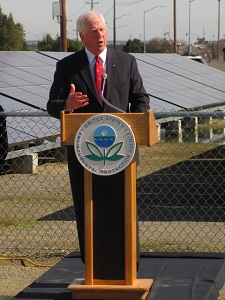EPA uses solar to clean up Frontier Fertilizer Superfund site
 The Environmental Protection Agency (EPA) said it cut the cleanup time at the Frontier Fertilizer Superfund site in Davis, Calif., from 150 years to 30 years, and would power most of the effort with photovoltaics. The agency is looking to adopt similar models at other Superfund sites across the country.
The Environmental Protection Agency (EPA) said it cut the cleanup time at the Frontier Fertilizer Superfund site in Davis, Calif., from 150 years to 30 years, and would power most of the effort with photovoltaics. The agency is looking to adopt similar models at other Superfund sites across the country.
During a media event on Feb. 23, Calif. Rep. Mike Thompson (D) joined EPA officials and California EPA officials to switch on new remediation system components at the Frontier site, which will reduce the cleanup time to 30 years and abate more than 54 metric tons of carbon dioxide annually. The approach consists of two steps: groundwater remediation—powered entirely by photovoltaics—and a ground-heating system that forces contaminants to collection sites much more quickly than previously, said EPA Site Manager Bonnie Arthur.
The new ground heating system is short-term.
“The heating is only for 1.5 years. That gets the mass [of contamination] that is still in the soil between 40-90 feet,” Arthur said. That process, which will heat the contaminated earth to the level of boiling water, will remove the lion’s share of the contamination.
Without the heating system, contaminates, including ethylene dibromide, dichloropropane, and carbon tetrachloride, would take generations to reach the groundwater where they could successfully be remediated.
However, since the heating unit is being used for less than two years, the EPA couldn’t justify installing a 1-megawatt photovoltaic system that could have powered the entire operation.
“We can’t because the way the law is set up. Under the national contingency plan, we can’t pay more for that type of installation because the heating is only for a year and a half. We looked at moving it—at so many different options,” she said.
With the new system in place, the solar-powered groundwater pumps will now be able to remediate the groundwater in 30 years.
“We beefed it up to completely go solar. We’re doing net-metering to produce more electricity in spring, summer and fall to balance it out in the winter,” Arthur said.
The agency is looking to green energy for other Superfund projects Arthur said.
“It’s a really big policy [for us] to try to use greener remediation,” she said. It also makes sense at remote locations with no grid connections. For instance, “We’ve got mining sites way out in nowhere.”
At this point, it’s easier for the EPA to integrate renewables than it is for private companies, Arthur said.
“I think we’re going to see more and more of it, [from private companies, too],” she said. “As the cost of solar is lowered, that will make a huge difference.”
Pictured: Rep. Thompson speaking at the event. Image courtesy of the Environmental Protection Agency.



